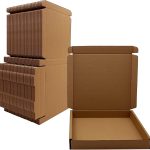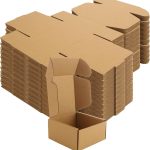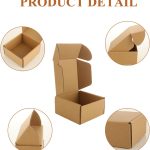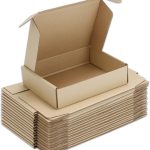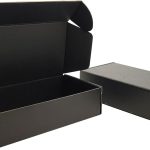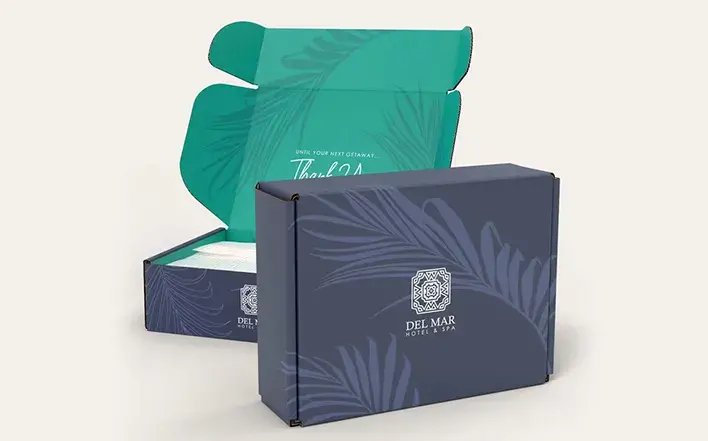Custom Kraft Corrugated Boxes
The automatic bottom lock corrugated box made of cowhide is very popular in some packaging industries, because the cowhide material on the surface of the box is very special and has a retro feel. Many customers' brands want to bring this retro and design feeling to their consumers. At the same time, the quick design of the automatic bottom lock is very convenient.
Kraft paper
- Material & Production
Crafted from wood fibers processed with alkaline chemicals, which enhances fiber strength. It’s typically unbleached, retaining a natural brown hue, though bleached (white) variants exist.
The long wood fibers give it exceptional tensile strength and tear resistance, making it durable for heavy-duty use.
- Key Properties
Strength: High resistance to breaking and tearing, ideal for holding heavy or bulky items.
Flexibility: Easily foldable and moldable without cracking, suitable for various packaging and crafting needs.
Eco-Friendly: Often sourced from renewable wood pulp and is highly recyclable, aligning with sustainable practices.
- Common Applications
Packaging: Used in shipping boxes, envelopes, shopping bags, and wrapping paper due to its protective qualities.
Food Industry: For coffee bags, cereal boxes, and food wrapping (often with a moisture-resistant coating).
Craft & Art: Popular for DIY projects, gift wrapping, and stationery due to its rustic aesthetic.
Industrial Use: As liners in corrugated cardboard, or for reinforcing materials in construction.
- Types & Variations
Unbleached Kraft: Natural brown, most common for packaging and heavy-duty use.
Bleached Kraft: White, used for aesthetic purposes in printing or premium packaging.
Waterproof Kraft: Treated with coatings to resist moisture, suitable for perishable goods.
Kraft Paperboard: Thicker variant used in rigid boxes or display partitions.
- Advantages
Balances durability with lightweight design, reducing shipping costs while ensuring product protection.
Its natural appearance conveys an eco-friendly, rustic image, appealing to sustainable brands.
Cost-effective and widely available, making it a staple in industries from logistics to retail.
Kraft paper’s combination of strength, sustainability, and versatility has made it a fundamental material in modern packaging and everyday products.
To achieve optimal printing results on kraft paper, it’s essential to address its unique surface properties and absorbency.
- Choose the Right Ink Type
Pigment-Based Inks: These offer better opacity and color vibrancy on kraft paper’s rough surface, as pigments sit on top of the fibers rather than soaking in. They are ideal for rich, saturated colors.
Solvent or UV-Cured Inks: These dry faster and adhere more strongly to the fibrous surface, reducing smudging and improving durability. UV inks, in particular, cure instantly under ultraviolet light, minimizing bleeding.
Avoid Water-Based Inks: These tend to bleed and fade more easily on uncoated kraft paper due to high absorption.
- Prepare the Paper Surface (Pre-Treatment)
Coat with Primer or Varnish: Apply a thin, transparent primer or matte varnish to create a smoother, less porous surface. This helps ink sit evenly and reduces absorption, enhancing color vibrancy and print sharpness.
Consider Lamination or Pre-Coating: For high-quality prints, use pre-coated kraft paper with a thin polymer layer, which mimics the surface of regular printing paper.
- Manage Color and Design for Kraft Paper
Account for the Brown Base Tone:
Use darker or more saturated colors (e.g., deep blues, reds, or blacks) to contrast with the kraft background.
Avoid light or pastel hues, as they may appear washed out; instead, use white ink as a base layer for light colors to improve visibility.
Use Color Calibration Tools: Pre-test color swatches on the specific kraft paper stock to adjust CMYK profiles and ensure accurate color reproduction.
Simplify Design Elements: Prioritize minimalistic designs with high contrast to avoid detail loss from ink bleeding.
- Choose the Right Printing Method
Flexographic Printing: Suitable for large batches, as it uses flexible plates and can apply thick ink layers, ideal for kraft paper’s absorbency.
Digital Printing with Specialized Equipment: Modern digital presses with pigment inks and high-opacity settings work well for small batches or custom designs.
Offset Printing with Adjustments: If using offset, increase ink viscosity and reduce water content in the fountain solution to minimize bleeding.


